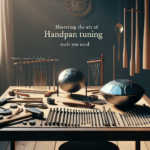Introduction
The handpan is a mesmerizing instrument known for its ethereal sound and unique design. However, maintaining its beautiful harmonics requires careful tuning. Mastering the art of handpan tuning is crucial for ensuring that your instrument continues to produce its characteristic soothing tones. This article offers a step-by-step guide to achieving perfect handpan tuning.
Understanding Handpan Structure
Before diving into the tuning process, it is important to understand the basic structure of the handpan. A typical handpan consists of two convex steel shells glued together, forming an airtight hollow body. The upper shell, known as the ‘dome,’ contains the central ‘Ding’ and several surrounding tone fields, while the bottom shell usually contains a hole referred to as the ‘Gu.’
Essential Tools and Equipment
To tune a handpan effectively, you will need some essential tools and equipment, including:
- Tuning Hammer
- Chromatic Tuner
- Tuning Forks
- Ear Protection
Step-by-Step Tuning Process
Step 1: Initial Assessment
Begin by assessing the current tuning of your handpan. Use a chromatic tuner to identify any off-pitch notes. Play each note individually and note any discrepancies between the sound produced and the desired pitch.
Step 2: Isolate the Problem Areas
Once you have identified the notes that require adjustment, isolate the problem areas. Focus on one note at a time to ensure precise tuning.
Step 3: Adjusting the Pitch
To adjust the pitch, gently tap the edge of the tone field with a tuning hammer. Use subtle and controlled force to avoid damaging the instrument. Continuously monitor the pitch using the chromatic tuner and make small adjustments as needed. Be patient, as fine-tuning requires precision and time.
Step 4: Checking Overtones
After tuning the fundamental pitch, check the corresponding overtones. The handpan produces multiple overtones that must be in harmony with the fundamental note. Use a tuning fork to identify and adjust these overtones as necessary.
Step 5: Reassessing the Tuning
After making the necessary adjustments, reassess the overall tuning of your handpan. Play each note again, both individually and in combination with others, to ensure a coherent and harmonious sound.
Maintaining Your Handpan
Proper maintenance is essential to prolong the tuning stability of your handpan. Here are some tips for maintaining your instrument:
- Store your handpan in a temperature-controlled environment to prevent thermal stress on the metal.
- Regularly clean the surface of your handpan with a soft cloth to remove dust and debris.
- Avoid exposing your handpan to excessive moisture, as this can cause rust and other damage.
Advanced Tuning Techniques
For those looking to delve deeper into the art of handpan tuning, several advanced techniques can further refine the sound of your instrument:
Fine-tuning the Gu
The ‘Gu’ hole at the bottom of the handpan can also be tuned to enhance the overall resonance of the instrument. Use a combination of tuning hammers and tuning forks to adjust the pitch and harmonics of the Gu.
Experimenting with Scale Modifications
Experimenting with different scales and tunings can add a unique touch to your handpan’s sound. Take the time to explore different tuning configurations and discover new musical possibilities.
Conclusion
Mastering the art of handpan tuning is a rewarding journey that requires patience, precision, and a keen ear for music. By following the step-by-step guide outlined in this article and applying the advanced techniques, you can maintain and even enhance the beautiful harmonics of your handpan. Remember that regular maintenance and proper care are crucial for ensuring the longevity and stability of the instrument’s tuning. Happy tuning!
FAQs
1. How often should I tune my handpan?
The frequency of tuning depends on how often you play your handpan and the conditions in which it is stored. Generally, a handpan should be tuned every 6-12 months.
2. Can I tune my handpan myself, or do I need a professional?
While it is possible to tune your handpan yourself with the right tools and knowledge, it is recommended to seek professional assistance if you are inexperienced to avoid damaging the instrument.
3. What should I do if my handpan gets dented?
If your handpan gets dented, it is crucial to have it repaired by a professional tuner. Attempting to fix dents yourself can lead to further damage and affect the tuning.
4. Can weather conditions affect the tuning of my handpan?
Yes, extreme temperatures and humidity can affect the tuning and overall condition of your handpan. It is best to store the instrument in a controlled environment to prevent issues caused by weather fluctuations.
5. How can I protect my handpan during transportation?
When transporting your handpan, use a padded case or bag to protect it from impacts. Additionally, avoid exposing it to extreme temperatures or moisture during travel.





